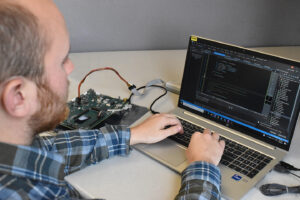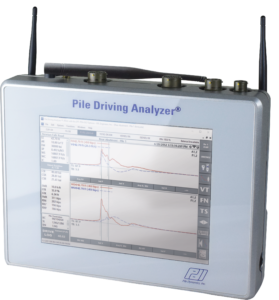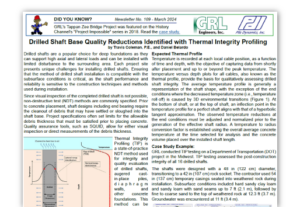How are the energy quantities for the PDA-8G (EMX, EFV, ETR and ETH) and for the SPT Analyzer (EMX, EFV, ETR, E2E, E2F, EF0, EF2, EV2) calculated?
To calculate EMX, take the maximum of the integral of force times velocity, over the whole record. In doing so, the maximum energy transferred to the foundation or SPT rod is calculated. The American Society for Testing and Materials (ASTM) 4633 and European Standard ISO 22476-3 only approve EMX for energy calculations. EMX is independent of the length (LE) setting because it searches the whole record. ETRETR (%) is calculated by comparing the EMX value to the rated energy of the hammer. In the equation below, PE represents the maximum rated potential energy of the hammer:
ETRETR (%) = 100 * EMX/PE
Additionally, the PDA-8G calculates ETH, which can only be used with open end diesel hammers. Calculate ETH as:
ETH(%) = 100 * EMX/(Wr * STK)
In this equation, Wr is the weight of the ram. STK is the open end Diesel stroke. The PDA-8G calculates STK based on the time between blows. EFV is the same as EMX. It is provided for consistency with ASTM D4633 terminology. The E2E method does the same computation as EMX, but stops the integration at (2 * LE)/c. This method can stop the integration at a time that corresponds to a given LE setting. Nevertheless, ASTM 4633 and European Standard ISO 22476-3 do not recommend stopping the integration before the record’s end. Moreover, changing LE will alter the capacity calculations on PDA testing.
As stated in earlier versions of ASTM D4633, EF2 was used to calculate SPT energy measurements. To calculate EF2, take the maximum of the integral of the square of the force divided by the impedance, over the whole record. It is based on the theoretical proportionality between force and velocity along most of the first 2L/c period on SPT energy tests. Engineers used the EF2 method before a more reliable method for measuring the velocity on SPT rods was available. In real practice, this proportionality is hard to achieve due to non-uniformity along the rod, imperfect joints, etc. A plethora of other factors affect the accuracy of this method, which results in the need for several correction multipliers. Later, engineers recognized that the correction methods did not yield reliable results. For further information, refer to the ASTM D4633 Appendix.
Generally, EF2 is inaccurate, obsolete, and should not be used. EF0 is the same as EF2. The E2F method does the same computation as EF2, but stops the integration at 2L/c. As a result, the E2F method exhibits the same inaccuracy as EF2. To calculate EV2, take the maximum of the integral of the square of the velocity multiplied by the impedance, over the whole record. Consequently, EV2 is based on the same proportionality principle as EF2, causing the same inaccuracy. PDI emphasizes that engineers should not use EF2, EF0, E2F, or EV2 when determining the energy transferred to a SPT rod or foundation. These energy quantities are provided for research purposes only.
Return to FAQs



